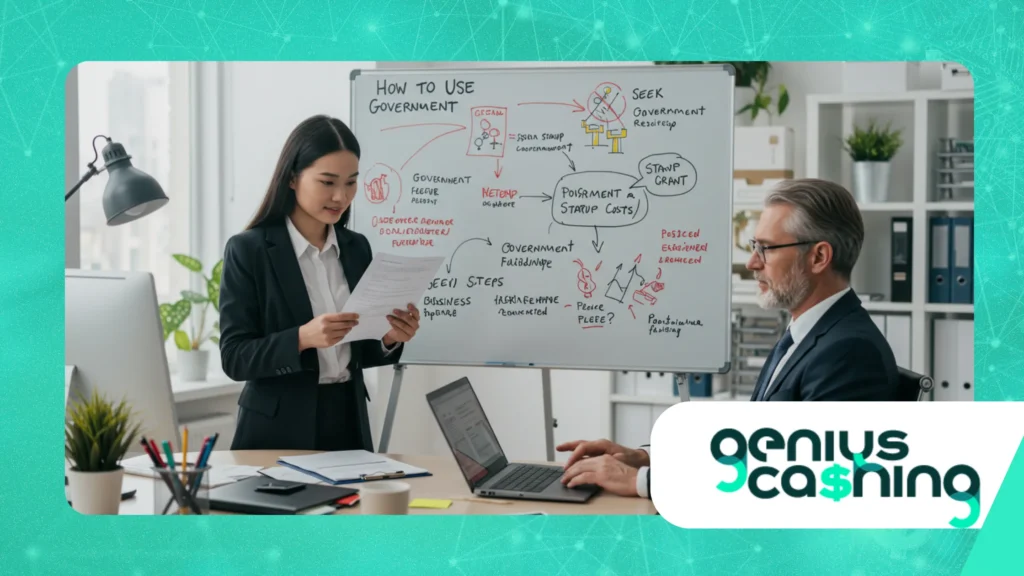How to Use Government Benefits to Offset Startup Costs

Starting a business is a thrilling leap, but the financial hurdles can feel like scaling a mountain without a rope. To use government benefits to offset startup costs offers a lifeline for entrepreneurs aiming to turn dreams into reality without drowning in debt.
Anúncios
In 2025, governments worldwide are doubling down on supporting startups, recognizing their role in driving innovation and economic growth.
This guide dives deep into leveraging these programs with precision, offering actionable strategies, real-world examples, and a fresh perspective on navigating the maze of public resources.
Whether you’re launching a tech venture or a local café, understanding how to tap into these benefits can make or break your early success. Ready to transform government support into your startup’s secret weapon? Let’s explore how.
Understanding the Landscape of Government Benefits
Government benefits for startups aren’t just tax breaks or loans; they’re a buffet of opportunities tailored to ease financial strain.
Anúncios
From grants to subsidized training, these programs aim to fuel entrepreneurial ecosystems. In 2025, the U.S. Small Business Administration (SBA) reports that over $50 billion is allocated annually to small business support programs.
Knowing what’s available is the first step to unlocking this potential. Programs vary by region, but most focus on reducing upfront costs, fostering innovation, and creating jobs.
Think of it like a gardener tending to new plants governments provide the water and nutrients so startups can grow.
Beyond financial aid, benefits include mentorship, workspace subsidies, and regulatory relief. For instance, the U.S. offers the SBIR (Small Business Innovation Research) program, which funds R&D for tech startups.
Navigating this landscape requires research and strategy. Not every program fits every business, so pinpointing the right ones is crucial.
++ Business Subsidies: What No One Tells You About the Fine Print
Ask yourself: what specific costs can I cut with government help? This clarity drives effective applications. Entrepreneurs who skip this step risk missing out on funds that could propel their vision forward.
The diversity of benefits can feel overwhelming, but that’s where opportunity lies. Local, state, and federal programs often overlap, offering layered support.
For example, a startup in California might combine state tax credits with federal grants. Understanding eligibility criteria such as business size or industry helps you target the best options.
Don’t assume you’re ineligible; many programs are designed for early-stage ventures. Digging into these resources is like mining for gold: the effort pays off if you know where to look.

Grants: The Holy Grail of Startup Funding
Grants are the crown jewel of government benefits, offering non-repayable funds to kickstart your venture.
To use government benefits to offset startup costs through grants means accessing free money if you qualify.
The U.S. Department of Commerce’s Economic Development Administration (EDA) provides grants for businesses in underserved areas, often covering equipment or facility costs.
These funds don’t require equity or repayment, making them ideal for cash-strapped founders. However, competition is fierce, and applications demand precision.
Also read: Government vs. NGO Support: Which One Offers More for Your Business?
Crafting a winning grant proposal requires storytelling and data. Highlight your business’s impact, like job creation or community benefits.
For example, GreenTech Innovations, a fictional solar startup, secured a $100,000 EDA grant by emphasizing local job growth.
Tailor your pitch to the grant’s goals whether innovation or economic development. Deadlines are strict, so plan ahead. Missing a submission window could mean waiting another year.
Beyond federal grants, explore state and local options. Cities like Austin offer microgrants for tech startups, often under $50,000. These smaller sums can cover initial costs like software or marketing.
Researching regional programs through government websites or local chambers of commerce is key.
Don’t overlook niche grants for women, veterans, or minority-owned businesses. They’re often less competitive and highly targeted, boosting your chances.
Tax Credits and Incentives: Cutting Costs Creatively
Tax credits are a powerful tool to use government benefits to offset startup costs, slashing your tax burden and freeing up capital.
The Research and Development (R&D) Tax Credit, for instance, allows U.S. startups to claim up to 20% of qualified expenses like software development or prototyping.
This can mean thousands in savings for tech-driven ventures. Unlike grants, tax credits don’t require lengthy applications, but you need meticulous records to prove eligibility.
State-specific incentives add another layer of savings. For example, New York’s Excelsior Jobs Program offers tax credits for startups creating jobs in high-tech sectors.
Read more: The Freelancer’s Survival Guide to Navigating Public Assistance
A fictional startup, CodeCrafters, used this to save $15,000 on payroll taxes in 2024. Check your state’s economic development website for similar programs. Timing matters some credits apply only to specific fiscal years. Missing these deadlines is like leaving money on the table.
Don’t ignore smaller incentives, like property tax exemptions for startups in enterprise zones. These areas, often in economically challenged regions, offer breaks to attract businesses.
Combining multiple credits federal, state, and local can compound savings. Consult a tax professional to maximize benefits without tripping over IRS rules. It’s like assembling a puzzle: each piece adds to the bigger picture of financial relief.
Subsidized Loans: Borrowing with a Safety Net
Government-backed loans provide affordable financing to use government benefits to offset startup costs without the crushing terms of private lenders.
The SBA’s 7(a) loan program, for example, offers up to $5 million with low interest rates and flexible repayment terms.
These loans can cover equipment, inventory, or working capital. In 2024, the SBA approved over 50,000 such loans, averaging $400,000 each. Startups with limited credit history often qualify, making this a game-changer.
Unlike traditional loans, government-backed options come with counseling and support. The SBA pairs borrowers with mentors to ensure repayment success.
Take Maria’s Bakery, a fictional startup that secured a $50,000 SBA microloan to buy ovens. The mentorship helped her manage cash flow, avoiding default.
Research programs like these through SBA.gov or local business development centers. Eligibility often hinges on a solid business plan.
Be cautious of loan terms and repayment schedules. While government loans are forgiving, they’re not free money.
Compare options like the USDA’s Rural Business Development Loans for rural startups. Each program has unique benefits, like lower collateral requirements. It’s like choosing the right tool for a job pick the one that fits your startup’s needs best.
Training and Mentorship: Building Skills on a Budget
Government programs often include free or low-cost training to use government benefits to offset startup costs by equipping founders with skills.
The SBA’s SCORE program connects entrepreneurs with experienced mentors at no cost. These mentors guide you through marketing, financial planning, and more.
In 2025, SCORE plans to expand virtual workshops, making access easier. Knowledge gained here can save thousands in consulting fees.
Local governments also offer subsidized training. For instance, Chicago’s Small Business Center provides free workshops on digital marketing.
A fictional entrepreneur, Jake, learned SEO basics through one such program, boosting his startup’s online visibility without hiring an agency.
Check your city’s economic development office for similar offerings. These programs often target specific industries, like tech or retail.
Don’t underestimate the value of networking through these initiatives. Mentorship programs connect you with peers and industry leaders, opening doors to partnerships or funding.
It’s like planting seeds for future growth nurture these relationships early. Regularly check government websites for updated training schedules. Missing out means losing free expertise that could shape your startup’s trajectory.
Navigating Application Processes: Tips for Success

Applying for government benefits can feel like decoding a secret language, but preparation is key to use government benefits to offset startup costs effectively.
Start by researching eligibility on official government portals like Grants.gov. Each program has specific requirements, like business size or revenue caps.
Gather documents business plans, financial statements before applying. Incomplete applications are often rejected outright.
Tailor your application to the program’s goals. For example, a grant focused on sustainability wants evidence of environmental impact.
A fictional startup, EcoPack, won a $75,000 green grant by showcasing its biodegradable packaging. Be concise yet compelling in your narrative.
Avoid jargon; clarity wins. Deadlines are non-negotiable, so use tools like Trello to track submission dates.
Seek free assistance from Small Business Development Centers (SBDCs). They offer guidance on applications, increasing your approval odds.
In 2024, SBDCs helped over 200,000 businesses secure funding. Don’t rush sloppy applications signal unreliability. Treat the process like a pitch to investors: professional, polished, and purposeful.
Local and Niche Programs: Hidden Gems for Startups
Beyond federal aid, local and niche programs offer targeted support to use government benefits to offset startup costs for specific communities.
Cities like Seattle provide grants for minority-owned startups, often under $25,000. These funds cover marketing, rent, or equipment.
Research your local government’s economic development page for tailored opportunities. Every region has unique offerings.
Niche programs focus on underrepresented groups. For example, the Amber Grant offers $10,000 monthly to women-led startups.
A fictional entrepreneur, Sarah, used this to fund her eco-friendly apparel line’s launch. Veteran or disability-focused programs also exist, often with less competition. These grants are like rare coins valuable if you know where to find them.
Engage with local business networks to uncover these opportunities. Chambers of commerce or industry groups often share insider tips.
In 2025, digital platforms like LinkedIn amplify these announcements, so stay active online. Combining local and niche benefits with broader programs maximizes your funding potential. It’s about stacking small wins for big impact.
Table: Key Government Benefits for Startups in 2025
| Program | Type | Max Funding | Eligibility | Best For |
|---|---|---|---|---|
| SBA 7(a) Loan | Loan | $5M | Small businesses, good credit | Equipment, working capital |
| SBIR Grant | Grant | $2M | Tech startups, R&D focus | Innovation, product development |
| R&D Tax Credit | Tax Credit | 20% of expenses | Businesses with R&D activities | Tech, software, prototyping |
| SCORE Mentorship | Training | Free | All startups, no restrictions | Business skills, strategy |
| Amber Grant | Grant | $10,000 | Women-led businesses | Marketing, early-stage costs |
Source: SBA.gov, Grants.gov, 2025
Conclusion: Your Path to Startup Success
Harnessing government benefits is like finding a hidden shortcut in a marathon it doesn’t guarantee victory, but it gives you a head start.
To use government benefits to offset startup costs in 2025 means tapping into grants, tax credits, loans, and training to build a resilient business.
From the SBA’s $50 billion commitment to small businesses to local microgrants, these resources are designed to empower entrepreneurs like you.
The key is action: research diligently, apply strategically, and leverage every opportunity.
Imagine your startup thriving because you seized these tools why wait to make that vision real? Start exploring today, and turn government support into your competitive edge.
FAQs: Your Questions Answered
Q: How long does it take to secure government benefits for startups?
A: It varies—grants may take 3–6 months, loans 1–3 months. Start early and track deadlines.
Q: Can startups in any industry apply for these benefits?
A: Most industries qualify, but tech, green, and job-creating startups often get priority.
Q: Are government loans risky for startups?
A: They’re safer than private loans, with lower rates and mentorship, but repayment is still required.
Q: How do I find local programs?
A: Check city economic development websites, join chambers of commerce, or network on LinkedIn.
